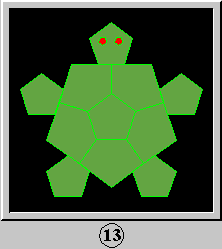 |
A presentation by Dr. Mike Charles EDUC 543 Integrated Methods III: Teaching Mathematics, Science, and Health in the Early Childhood, Elementary, and Middle School Pacific University College of Education Images from Yehuda Katz' Logo art gallery at |
 |
 |
A presentation by Dr. Mike Charles EDUC 543 Integrated Methods III: Teaching Mathematics, Science, and Health in the Early Childhood, Elementary, and Middle School Pacific University College of Education Images from Yehuda Katz' Logo art gallery at |
 |
| Logo is a computer programming language that students of many
different ages can use to explore mathematical ideas. It was developed
at the MIT Media
Laboratory by a team of people led by Dr. Seymour Papert. Papert wrote
a
book called Mindstorms back in 1980 that has had a significant
impact
on how people think about technology and education. In fact, some
describe
Logo as an educational philosophy as much as it is a particular
computing
language. Logo was designed as a computer language to learn with
instead
of a language to learn about. These days there is a website
dedicated
to Papert and some of his thinking and projects--see http://www.papert.org/.
Learning objectives Students will be able to: (objectives in italics were NOT addressed in Fall 2008)
Connections to the NCTM Standards 2000 As done in class, I would suggest that this lesson would be appropriate for grades 4-6, though it could be adapted for much younger students. It addressed the following Standards from the PreK-2, Grades 3-5, and the Grades 6-8 expectations. Note: I identify all 3 strands here to show the relevance of this lesson to multiple levels of students, but normally you will attend to the expectations in only one of the grade strands. Number and Operations
Algebra
Geometry
Measurement
Data Analysis and probability
In addition, the online NCTM "e-examples" features a couple of
Logo
based activities as exemplary activities for learning geometry in
grades
K-2. See "Learning Geometry and Measurement Concepts by Creating Paths
and
Navigating Mazes: Hiding Ladybug" available at: http://standards.nctm.org/document/eexamples/chap4/4.3/index.htm Where to get Logo for your school Logo is available for free on the web for either the Windows or Mac platform. MSW Logo is for Windows computers and available at http://www.softronix.com/logo.html UCB Logo is the original code used in creating MSW Logo. It is
a
Macintosh program written by Brian Harvey and known also as UCB Logo.
To
directly download a stuffed copy of UCB Logo onto your computer, go to
Brian's website at http://www.cs.berkeley.edu/~bh/
and click on the complete distribution archive for the Mac OS X version
nof UCB Logo. Additional Logo resources: If you’d like to learn more about Logo, see A Turtle for the Teacher, a tutorial written by an Australian teacher named Paul Dench. The Logo Foundation is a great place to "find information and resources for learning and teaching Logo." For a look at some great Logo projects, see the Logo art
gallery
by Yehuda Katz (from Israel) & Olga Tuzova (from Russia) available
at: http://www.geocities.com/CollegePark/Lab/2276/
(click on "Logo Art Gallery") |